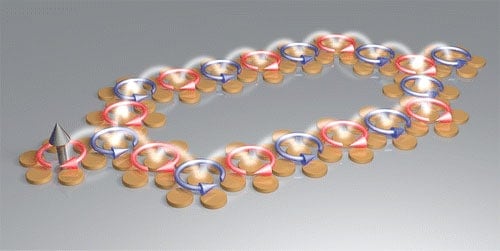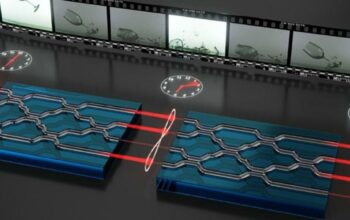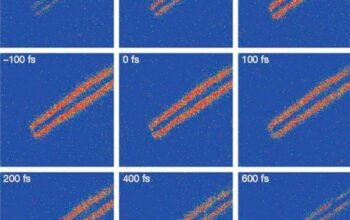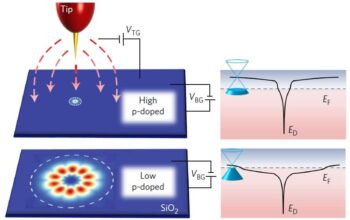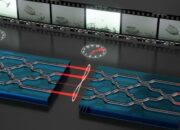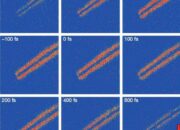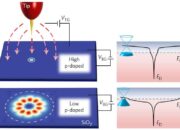The intersection of molecular physics and nanotechnology is witnessing transformative advancements, particularly in the realm of magnetic plasmons. Plasmons, which are coherent oscillations of free electron gas, have gained traction for their potential to manipulate electromagnetic waves at the nanoscale. The innovative approach of utilizing fused molecules as guiding structures for magnetic plasmons offers a promising shift in perspective, and it is imperative to explore the underlying mechanisms and implications of this development.
To comprehend the significance of fused molecules guiding magnetic plasmons, it is essential to first delve into the fundamental properties of plasmons themselves. Plasmonic phenomena arise when electromagnetic waves interact with the conduction electrons of metals, resulting in a phenomenon that can be harnessed for applications ranging from sensing to imaging and even photovoltaic devices. The manipulation of these plasmons has traditionally been constrained to surface plasmons, which occur at the interface between a conductor and dielectric. Recent explorations into magnetic plasmons, however, expand the paradigm, allowing for the integration of magnetic interactions in tandem with electronic excitations.
Fused molecules, which are typically comprised of complex organic compounds forming covalent bonds, introduce unique functionalities that have yet to be fully exploited in plasmonic applications. By combining distinct molecular components, researchers can engineer materials that not only support plasmonic activity but also facilitate novel magnetic characteristics. Such integration opens a plethora of avenues for enhancing the efficiency and efficacy of plasmonic devices. It is the fusion of these characteristics that catalyzes a new conceptual framework regarding the manipulation and propagation of plasmons.
The enhancement of magnetic plasmons through the use of fused molecules can be fundamentally attributed to the structural attributes of these molecules. The confinement of electrons within the interconnected geometric structures of fused molecules creates a conducive environment for the generation of magnetic dipoles. When these dipoles interact with external electromagnetic fields, the result is a modulation of the plasmonic behavior, leading to the excitation of magnetic plasmons. The tunability of these molecular constructs allows for the engineering of resonant frequencies, thereby enhancing their compatibility with specific applications.
An intriguing aspect of this innovation lies in the prospect of achieving high spatial resolution and control over the propagation of magnetic plasmons. The ability to guide these plasmons through engineered fused molecular structures facilitates the creation of more sophisticated photonic circuits. Such circuits could potentially revolutionize data transmission, offering unprecedented bandwidth and speed while simultaneously minimizing energy losses. The diminished scale of these devices correlates with a corresponding enhancement in performance; thus, the application of fused molecules could catalyze a new era of photonic technologies.
Moreover, the implications of guided magnetic plasmons extend beyond mere technological advancements. The nuanced interaction between plasmonic and magnetic components can lead to novel quantum phenomena. Quantum coherence, for instance, becomes a palpable avenue for exploration, where the interplay between light and matter can yield insights into fundamental principles of quantum mechanics. This intersection may prove pivotal for the development of quantum computing technologies, where harnessing the unique properties of quantum states is essential for computational efficiency.
The synthesis of these fused molecules, however, is not without its challenges. The precise control over molecular assembly is paramount. Researchers must navigate the subtleties of chemical bonding, sterics, and electronics to create structures that possess the requisite plasmonic and magnetic properties. Advanced techniques such as self-assembly and lithography may provide scaffolds for such endeavors, allowing scientists to construct these intricate molecular architectures with precision. It is a testimony to the optimism surrounding this field that interdisciplinary collaboration between chemists, physicists, and materials scientists is becoming increasingly essential.
The potential applications for fused molecules guiding magnetic plasmons are sweeping in their scope. One significant domain is in the realm of biomedical technologies. The capability to manipulate light at the nanoscale can lead to groundbreaking advancements in imaging techniques, allowing for enhanced contrast in diagnostic procedures. Furthermore, the controlled release of pharmaceuticals can be achieved through nanocarriers designed with plasmonic properties, potentially revolutionizing drug delivery systems. Such implications underscore a critical point: the synthesis of knowledge in molecular design, coupled with advanced plasmonic interactions, can yield healthcare solutions that were once relegated to the realm of science fiction.
In conclusion, the pioneering concept of utilizing fused molecules to guide magnetic plasmons brings to the fore an exciting frontier in photonics and materials science. The convergence of magnetic and plasmonic phenomena not only enhances the efficiency of existing technologies but also paves the way for innovations that could redefine our approach to data transmission, biomedical applications, and quantum technologies. The journey ahead, while laden with technical challenges, promises a fertile ground for scientific inquiry and technological advancement, compelling one to consider the profound ramifications of this research. As the field continues to evolve, it is incumbent upon the scientific community to explore these revelations with vigor and curiosity, ensuring that the fruits of such innovation benefit society at large.
